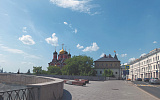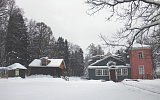Ever since the MiG designer bureau on Jan. 12, 1999, demonstrated its latest plane, the scandal around the program of development of a multifunctional front fighter jet of the fifth generation, known as project 1.42, has been raging.
First of all it is necessary to specify what the "fifth generation" means. Although there seems to be no clear definition of the term, a fifth generation fighter jet is expected to have super maneuverability, capacity to carry out a supersonic cruise flight without force regime for its engines, small visibility in radar and infra-red diapasons, possibility to be in operation by taking off and landing in short strips, capability to stage effectively an air battle without a visual contact with the enemy.
Although the MiG shown at the Zhukovsky aviation constructors fair can still be modified, changes are unlikely to be dramatic. It is a multifunctional one-pilot jet shaped according to an aerodynamic scheme "duck" with middle placed three-cornered wing and a V-like tail unit.
This is the first such aerodynamic design in Russia. Meanwhile, MiG"s opponents are pointing out seven design features incompatible, in their view, with the "stealth" technology. Because of this, they say, MiG cannot be called a fifth generation plane.
MiG"s seven cardinal sins are the absence of the sights and navigation unit, an antiradar system, and an on-board radar station; the traditional shape of its air scoops; the absence of room within the fuselage for missiles; the presence of pylons for outward missile-carrying hinges; the traditional covering and paint work, and traditional (round) nozzles of the engine.
Straight away it is to note: the thesis on the absence of sight-navigation complex is not serious. First, nobody saw what is available under the radio-transparent covering of nose fairing, and what is there - technological equipment or an empty room - it is not known. It is also impossible to get any detailed specifications because apart from the exterior image all other parameters and characters of this fighter are secret.
Up till now it was only said that this fighter will be capable to give a long-range air battle and hit at the same time more than 20 targets. Second, it is quite clear that today this fighter does not need a full set of on-board electronics. The tasks of the initial phase of testing can be solved successfully also with a restricted number of board equipment.
The main thing - is availability of means for communication, navigation and equipment to safeguard instrumental landing ( such approach had been realized also by three experiment fighters F-22).
The same thing can be said about the lack of a radar and an antiradar system. What really matters is the engine and the airframe.
So do, in fact, the air scoops. F-22 has flank under-wing air scoops with rhomb-like sections. The new MiG"s air scoops are of a rectangular form and are located under the fuselage.
Generally speaking the shape of air scoops does not influence on anything. The main question is availability of S-like channels destined for screening of compressors' engines what bring a sharp drop for indicators of surface dispersion effectiveness in the front half-sphere. The version 1.44 have such channels although the air-foil of their distortion is manifested not so evidently as in the American aircraft.
But the room for missiles within the fuselage in reality is out in the demonstrated version. Perhaps, it will appear in the next experimental fighter. Later pylons for outward missile-carrying hinges would be taken away. This, of course, is viewed as a big minus for the project.
As for the traditional covering and paint work, Mikhail Korzhuyev, MiG"s general director, says that surface dispersion effectiveness of the fighter comes to 0.1 square meters. But this is only an estimate that may be corrected in the future. The real figure would be approximately one to three square meters.
It must be pointed out that a lower visibility in centimeter-long radar diapason was the result of selection among special small-reflecting forms and fighter's geometrical parameters. Covering of the planer surface with special radio absorbing materials can be done later.
Now to the traditional (round) nozzles of the engine. It is a fact, in F-22 the nozzles are flat with a regulation for the area of cross-section. This reduces the infra-red visibility of this fighter from the rear half-sphere. However, the fighter's designers rejected the idea to implement similar decision because the engine AL-41F with a flat nozzle want to be 2,5 times heavier than the traditional engine with a round nozzle.
Furthermore, it could result in a 10-14 percent decrease of the power of its engine. To reduce infra-red visibility of this fighter in the back half-sphere technological operations were worked out, and these decisions were put into effect by designing the engine AL-41F.
Finally, a number of technological innovations went into MiG"s design. For example, the resistance of the pilot to the g-force was optimized thanks to the use of special "compensation suits."
In a word, though probably superior to the F-22 in its aerodynamic characteristics (at least on paper), the new MiG will fall short of the American fighter in terms of its invisibility on radar screens and certain other design elements.





























